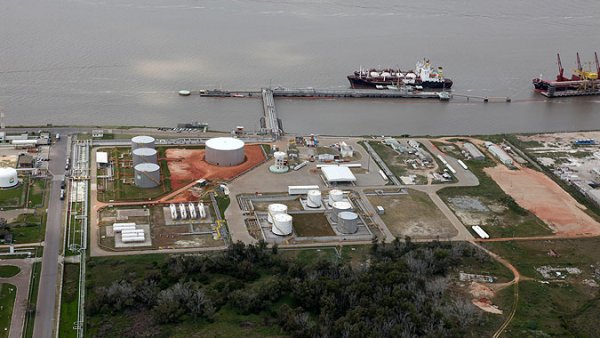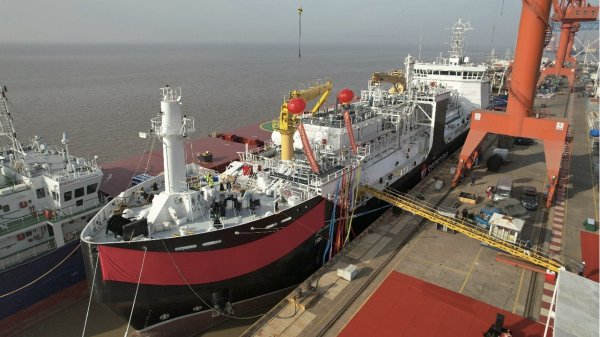Petrotrin eyes Panama bunker launch
Supplier signs storage MoU as part of its strategy to launch bunkering operations in Panama.
Oil and gas company Petroleum Company of Trinidad & Tobago Ltd. (Petrotrin) has signed a memorandum of understanding (MoU) with Melones Oil Terminal Inc., Panama, as part of its strategy to launch a bunkering operation in the Central American country.
In addition, the oil firm is said to be interested in signing two other MoUs; one with storage terminal operator Petrobunker S.A and another with Telfers Tanks.
The Melones Island oil terminal, located on the Pacific side of the Panama Canal, is currently under construction and expected to be in operation by the second quarter of 2012. The facility is a joint project between Panama firm Marine Engineers and US company ATEC Steel.
The 2.1 million-barrel terminal is being built in a Fuel Free Zone and will be managed and operated by Melones Oil Terminal, Inc.
Petrotrin is looking to enter Panama's fuel bunkering market, which is expected to experience growth with the expansion of the Panama Canal. By 2014, the Panama Canal is set to significantly increase its capacity, enabling larger ships to transit and providing greater efficiencies in global commerce.
Currently, the ports of Cristobal and Balboa - strategically positioned at each end of the Panama Canal - total approximately 14,000 transits per year and generate around 3 million metric tonnes of annual marine fuel sales volumes combined.
Bunker suppliers to have recently entered the Panama bunker market include Aegean Marine Petroleum SA, Bominflot and OW Bunker. Last year, Puma Energy, a subsidiary of Trafigura Beheer BV, agreed to acquire ExxonMobil's fuels marketing and supply businesses in Panama.
Melones Island is located less than eight nautical miles from the Pacific entrance to the Panama Canal.
"Melones Oil Terminal Inc., will establish the area with an investment of $65 million to operate, maintain and manage a complex of tanks, pumping stations, docks, and ducts for crude oil, semi-processed, derivative products, natural gas, biofuels, petrochemicals and others on Taboga and Melones islands," the Presidency of Panama said in a press release earlier this year.
The new terminal will have a total of 18 storage tanks: six 220,000-barrel tanks, six 100,000-barrel tanks, four 50,000-barrel tanks and two 10,000-barrel tanks. It will allow up to four barges to be loaded simultaneously out of four separate storage tanks with independent pipelines.
Transfer pumps for loading will have run rates of 3,500 barrels/hour for barges and 17,500 barrels/hour for ships. The berth positions will have a draft of 13 feet.
Additional features of the facility have been provided below.
Four, 3,500 bbl/hr bunkered product transfer pumps and two, 1,500 bbl/hr diesel fuel transfer pumps.
Two diesel driven fire water pumps provided with fresh water jockey pump.
Mass flow metering system for diesel to fuel oil blending suitable for simultaneous loadout to four barge docks.
Diesel driven and electric powered air compressor/ receivers.
Oil/water separator provided along with all auxiliary water removal pumps.
130 degree hot oil boiler systems for heavy fuel oil heating.
Self-contained sewage treatment system with lift systems.
Barge loading and ship unloading hydraulic operated docks.
Emergency shut down valves at dock, shore and tanks.
PLC programming and control systems.
Fresh water cistern system and pumping station.
In addition, the oil firm is said to be interested in signing two other MoUs; one with storage terminal operator Petrobunker S.A and another with Telfers Tanks.
The Melones Island oil terminal, located on the Pacific side of the Panama Canal, is currently under construction and expected to be in operation by the second quarter of 2012. The facility is a joint project between Panama firm Marine Engineers and US company ATEC Steel.
The 2.1 million-barrel terminal is being built in a Fuel Free Zone and will be managed and operated by Melones Oil Terminal, Inc.
Petrotrin is looking to enter Panama's fuel bunkering market, which is expected to experience growth with the expansion of the Panama Canal. By 2014, the Panama Canal is set to significantly increase its capacity, enabling larger ships to transit and providing greater efficiencies in global commerce.
Currently, the ports of Cristobal and Balboa - strategically positioned at each end of the Panama Canal - total approximately 14,000 transits per year and generate around 3 million metric tonnes of annual marine fuel sales volumes combined.
Bunker suppliers to have recently entered the Panama bunker market include Aegean Marine Petroleum SA, Bominflot and OW Bunker. Last year, Puma Energy, a subsidiary of Trafigura Beheer BV, agreed to acquire ExxonMobil's fuels marketing and supply businesses in Panama.
Melones Island is located less than eight nautical miles from the Pacific entrance to the Panama Canal.
"Melones Oil Terminal Inc., will establish the area with an investment of $65 million to operate, maintain and manage a complex of tanks, pumping stations, docks, and ducts for crude oil, semi-processed, derivative products, natural gas, biofuels, petrochemicals and others on Taboga and Melones islands," the Presidency of Panama said in a press release earlier this year.
The new terminal will have a total of 18 storage tanks: six 220,000-barrel tanks, six 100,000-barrel tanks, four 50,000-barrel tanks and two 10,000-barrel tanks. It will allow up to four barges to be loaded simultaneously out of four separate storage tanks with independent pipelines.
Transfer pumps for loading will have run rates of 3,500 barrels/hour for barges and 17,500 barrels/hour for ships. The berth positions will have a draft of 13 feet.
Additional features of the facility have been provided below.
Four, 3,500 bbl/hr bunkered product transfer pumps and two, 1,500 bbl/hr diesel fuel transfer pumps.
Two diesel driven fire water pumps provided with fresh water jockey pump.
Mass flow metering system for diesel to fuel oil blending suitable for simultaneous loadout to four barge docks.
Diesel driven and electric powered air compressor/ receivers.
Oil/water separator provided along with all auxiliary water removal pumps.
130 degree hot oil boiler systems for heavy fuel oil heating.
Self-contained sewage treatment system with lift systems.
Barge loading and ship unloading hydraulic operated docks.
Emergency shut down valves at dock, shore and tanks.
PLC programming and control systems.
Fresh water cistern system and pumping station.

|
IMO approves pricing mechanism based on GHG intensity thresholds
Charges to be levied on ships that do not meet yearly GHG fuel intensity reduction targets. |
|
|
|
||

|
VARO Energy expands renewable portfolio with Preem acquisition
All-cash transaction expected to complete in the latter half of 2025. |
|
|
|
||

|
NYK trials biofuel in milestone coal carrier test
Vessel is used to test biofuel for domestic utility company. |
|
|
|
||

|
H-Line Shipping orders LNG bunkering vessel
Vessel with 18,000-cbm capacity to run on both LNG and MDO. |
|
|
|
||

|
How to engineer and manage green shipping fuels | Stanley George, VPS
Effective management strategies and insights for evolving fuel use. |
|
|
|
||

|
Swedish government bans scrubber wastewater discharges
Discharges from open-loop scrubbers to be prohibited in Swedish waters from July 2025. |
|
|
|
||

|
MAN Energy Solutions achieves 100% load milestone for ammonia engine
Latest tests validate fuel injection system throughout the entire load curve. |
|
|
|
||

|
Petrobras secures ISCC EU RED certification for B24 biofuel blend at Rio Grande
Blend consisting of 24% FAME is said to have been rigorously tested to meet international standards. |
|
|
|
||

|
Stolt-Nielsen to fully control Avenir LNG with acquisition
Share purchase agreement to buy all shares from Golar LNG and Aequitas. |
|
|
|
||

|
Bureau Veritas supports launch of CIMC SOE's LNG bunkering vessel
Handover of Seaspan Energy's cutting-edge 7,600-cbm vessel completed. |
|
|
|
||
Related Links
- · Aegean launches supply operation in Panama [Insights]
- · Trafigura acquires Exxon fuels businesses [Insights]
- · Oiltanking acquires Panama bunker terminal [Insights]
- · Oiltanking acquires Panama bunker terminal [Insights]
- · Panama [Directory]
- · Panama Canal [Directory]
- · Balboa [Directory]
- · Cristobal [Directory]

